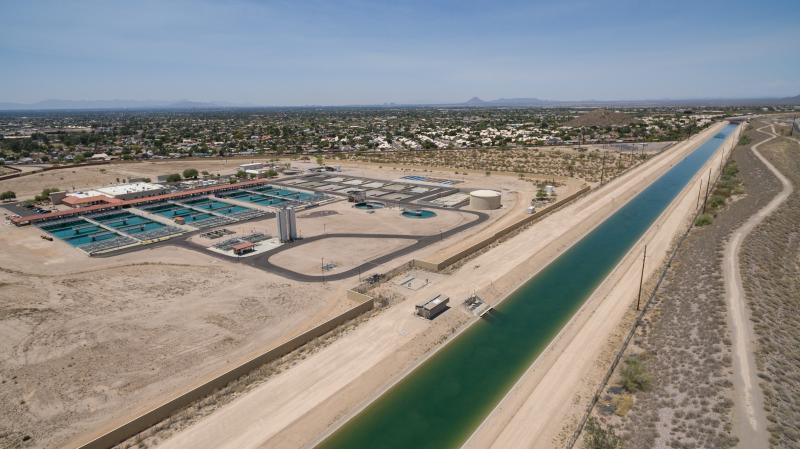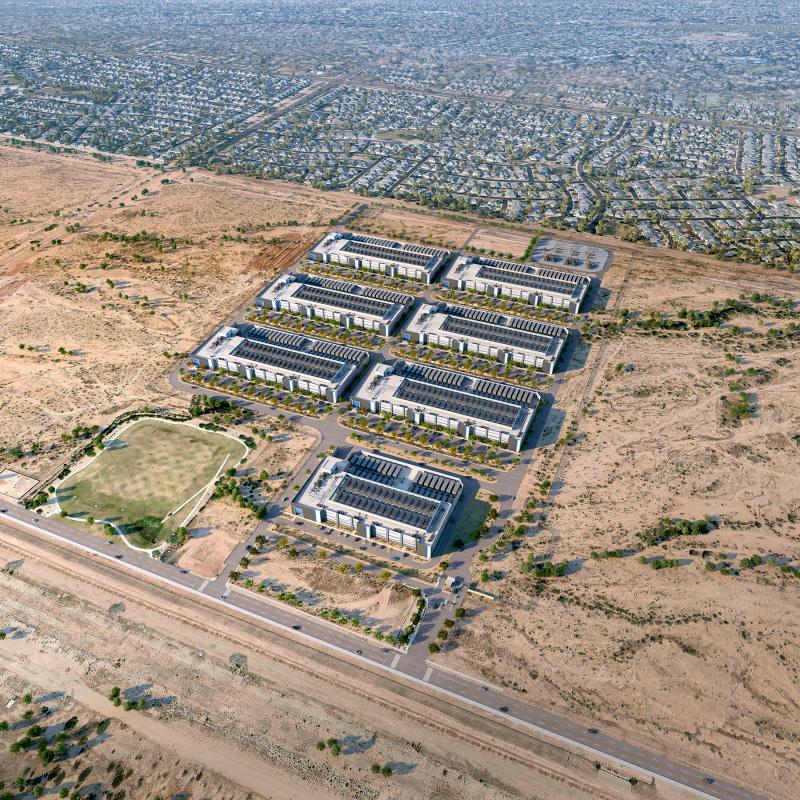Mesa’s water supply is secure despite Stage One Colorado River shortage declaration

"Mesa has a diverse water portfolio that not only includes the Colorado River, but also the Salt and Verde Rivers, and groundwater," said Jake West, Mesa Water Resources Director.
 "Mesa also has creative strategies for acquiring additional water supplies. For example, Mesa provides treated wastewater (effluent) to farms in exchange for vital surface water."
"Mesa also has creative strategies for acquiring additional water supplies. For example, Mesa provides treated wastewater (effluent) to farms in exchange for vital surface water."
Each valley city has their own water outlook, and Mesa has long prepared for shortage by investing in our infrastructure, water supplies, underground water storage and demand management programs.
Water allocations to Colorado River Basin states were made decades ago based on times of higher precipitation and lower demands. Drought conditions and rapid growth have put unprecedented demands on water supplies.
In anticipation of shortages and as one of many sustainable water management strategies, about two years ago the Mesa City Council approved the Large Customer Sustainable Water Allowance ordinance. This policy creates a water "budget" for large water users who project their demand to be a half-million gallons or more of water per day. The ordinance requires these large users to stay within their water budgets and in some cases, they must bring their own water to the table - for example, in the form of long-term storage credits. These credits are used over time to meet the large water demands of their business operations.
"We take water conservation and the shortage on the Colorado River very seriously--it is our  responsibility to be good stewards of these resources," said Mayor John Giles. "The Large Customer Sustainable Water Allowance ordinance is one of many ways Mesa is actively protecting our water supplies from being compromised, while balancing economic development opportunity for our city." The City of Mesa will continue to plan for further shortage and carefully manage water supplies. To learn more about Mesa's water stewardship strategy, visit www.mesaaz.gov/water. For tools and tips to save water, visit www.mesaaz.gov/conservation
responsibility to be good stewards of these resources," said Mayor John Giles. "The Large Customer Sustainable Water Allowance ordinance is one of many ways Mesa is actively protecting our water supplies from being compromised, while balancing economic development opportunity for our city." The City of Mesa will continue to plan for further shortage and carefully manage water supplies. To learn more about Mesa's water stewardship strategy, visit www.mesaaz.gov/water. For tools and tips to save water, visit www.mesaaz.gov/conservation
Contact: Weston Brown
(480) 644-5713
PLEASE NOTE THIS FROM THE SECOND REPORT BY TOM SCANLON
But, when the Tribune asked the names of the companies that will use a half-million gallons or more of water per day, a water department spokesman said he could not answer.
“Due to customer privacy protocol we cannot give out any information about our customers,” Weston Brown said.
When asked to provide the number of gallons consumed by Mesa’s biggest users, without providing the name, Brown again declined to answer.
“We are not able to disclose individual customer utility information including customer usage,” he said. He said an Arizona law makes it “unlawful for a person to procure a public utility record in Arizona without the authorization of the customer to whom the record pertains.”
============================================================================
 While monsoon storms pummeled Mesa, the federal government announced drought conditions at Lake Mead and the Colorado River will lead to significant cuts of Arizona water allocation.
While monsoon storms pummeled Mesa, the federal government announced drought conditions at Lake Mead and the Colorado River will lead to significant cuts of Arizona water allocation.
Mesa officials stressed the cuts will not directly impact the city.
Mayor John Giles said the city saw this coming long ago.
“Mesa has long prepared for this reality, with careful planning, an ongoing educational campaign for our residents and a robust Water Shortage Management Plan,” Giles said.
_____________________________________________________________________________
INSERT FROM AN EARLIER POST ON THIS BLOG
On top of the $150,000,000 for SBWTP and the $200,000,000 for the GWTP, take a look>
As you can see in the infographic to the right, the taxpayer burden for costs in the City of Mesa's FY17/18 Wastewater Treatment Bond Projects in this fiscal year's budget amount to $45,3000,000 > 23.9%.
Together with the costs of water at $80,9000,000 (42.5%) they consume 2/3 or 66.3% of the entire Budget Pie.
Wastewater costs more than 2X as much as the total amount spent on Parks and 5x as much as money spent on Electric.
_____________________________________________________________________________
Even so, some are wondering how a growing city that has been rolling out the welcome mat to water-guzzling data centers will deal with the potential of a dwindling water supply. . .
When City Council approved a development deal for a massive Facebook data center, Vice Mayor Jenn Duff was the lone voice of opposition.
“I cannot in good conscience approve this mega-data center using 1.4 million gallons per day,” Duff said, her voice cracking in emotion. “We already have seven or eight data centers in this area. Data Centers are not a responsible use of water and it’s time to stop and allow other forms of manufacturing and technology to infill.”
That was about two months before this week’s stunning declaration of the first-ever water shortage at Lake Mead, a reservoir on the Colorado River. After years of drought conditions, the Bureau of Reclamation said this week it will cut Arizona’s annual water from Lake Mead by 18 percent.
Hours before the announcement, the Mesa Water Department fired off its own press release about the water shortage and cuts to Arizona. . .
“The city of Mesa has anticipated this declaration based on current hydrology and months of speculation. Stage One shortage on the (Colorado) river does not affect supply to Mesa water customers,” it stated.
About 55 percent of Mesa’s water comes from the Colorado River/Lake Mead, delivered to the city via the Central Arizona Project. Salt River Project provides about 31 percent of Mesa’s water.
As water supplies are challenged
by droughts, Mesa’s demand for water has increased.
The current water use in Mesa is regularly published, but the city has not provided projected use figures to the Tribune. Asked for projections of commercial water use for the years 2022, 2023 and 2024, Weston Brown, a Mesa Water Department spokesman, referred to the 2018 Water Master Plan Update.
However, those years are not listed in the report – which was prepared before the development of the Elliot Tech Corridor in booming southeast Mesa. . .
Apple is the only data center in operation, with Google’s plans remaining a mystery. The others have started construction. Duff told the Tribune last week, “I have since learned we only have three of the data centers that use water. The others are air cooled.”
Even so, she added, “I still have concerns about data centers that use water for cooling in the desert. It is the most valuable resource we have in the desert.”
One big question: How much water will these huge data centers use?
. . .She is far from anti-data centers, noting, “Practically everything that is economic activity uses water. It’s not necessarily a question, ‘Is this a big water user or not? 'It's more what are the various benefits this commitment of water resources brings to the community.
“Every city should think about how it wants to use its water resources. That’s really what city councils are supposed to be doing,” Porter said.
“The thing people don’t like about data centers is they use a lot of water, but they don’t tend to provide a huge number of jobs and the jobs they have don’t tend to be super high-paying.”
> According to Melanie Roe, a Facebook spokeswoman, the Facebook data center in Eastmark will be a boon for Mesa.
“This data center will represent an $800 million investment, support 100-plus jobs in the data center and approximately 1,500 construction jobs at peak,” she said. . .
According to Roe, “We do not have an estimated water use number for this data center.” . . ..
“Arizona is drier and hotter, so we do anticipate it will likely require more water,” Roe said of the Mesa operation.
> Mesa has a “bring your own water” ordinance governing high-water users, though it involves credits, as opposed to actual water. . .As such, Mesa’s city code requires “the transfer of long-term storage credits to the city in order to maintain the water allowance….”
> The “high water mark,” so to speak, in Mesa was August 2020, when commercial users went through 1.3 million kilogallons and residents 1.6 million kilogallons (both were just a few sips higher than August 2017). . ."
___________________________________________________________________________
RELATED CONTENT
25 August 2019
If you missed the show on Monday, there's a post on this blog to view it.
There are 15 people in the image: a crowd. Some of that is explained below in an article from AZ Big Media.
16 November 2020
Water-Rights on 11,444 acres of land.
Brady justified that by stating that the city had 'plenty of water' in August 2019
19 August 2021
Japanese Government-Owned NTT Ltd Plans a 7-Data Center Campus Here on The Edge of Mesa's Dry Desert Sprawl
NTT announces LEED-certified, seventh US campus
17 August 2021 | Melanie Mingas

As part of the study, which was published Tuesday in Environmental Science & Technology Letters, the researchers examined concentrations of six types of PFAS chemicals in drinking water supplies around the country. The data came from more than 36,000 samples collected by the Environmental Protection Agency between 2013 and 2015









No comments:
Post a Comment